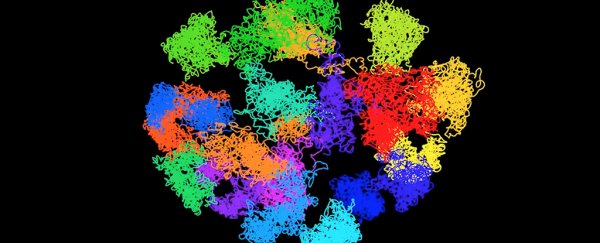For the first time, scientists have been able to model the physical structure of mammalian genomes from individual cells, giving us a unique 3D perspective on how DNA packages itself inside our cells.
Through the new technique, scientists can see how the arrangement of cell chromosomes (DNA strands) are designed to keep some cells active or inactive at any one time.
The procedure, which so far has been conducted on mice cells, could help us understand more about how animals grow, as well as how cell malfunction can lead to disease.
"Knowing where all the genes and control elements are at a given moment will help us understand the molecular mechanisms that control and maintain their expression," says one of the researchers, Ernest Laue from the University of Cambridge in the UK.
The genome can be thought of as the blueprint for our bodies, but different parts of the blueprint are used at different times, and cell structure could be crucial to how that's organised.
Considering human cells cram almost 2 metres (78.7 inches) of DNA into a nucleus about 0.005 millimetres (0.0002 inches) wide, this kind of packaging needs to be very precise.
In the study, the scientists looked at embryonic stem cells in mice – the so-called master cells that can be made to develop into any other type of cell.
They studied high-resolution images of eight cell genomes with an analytical method called Hi-C, in which genome structure can be calculated through the positioning of its DNA.
Although the team only captured between 1.2 and 4.1 percent of the possible number of DNA junctions inside the nucleus, thanks to the high-resolution images, they were able to assemble 3D structures from the data, and verify which genes were active and which weren't.
The technique gives scientists new insight into how the genomes inside the cells of mammals are assembled, and how that assembly affects their function.
The team produced two videos showing how the 3D structures look. In the first (seen above) 20 separate chromosomes are given different colours, and we can see how they fit together inside the cell.
In the second video, regions of the chromosomes where genes are active are coloured blue, whereas the yellow segments indicate less active genes that interact with the structure of the nucleus itself:
"Visualising a genome in 3D at such an unprecedented level of detail is an exciting step forward in research and one that has been many years in the making," says molecular scientist Tom Collins from the UK's Wellcome Trust, who wasn't involved in the research.
Collins says future studies could now look at how chromosomes interact with each other, and how DNA structure influences whether certain genes are switched on or off.
"If we can apply this method to cells with abnormal genomes, such as cancer cells," says Collins, "we may be able to better understand what exactly goes wrong to cause disease, and how we could develop solutions to correct this."
The research has been published in Nature.
